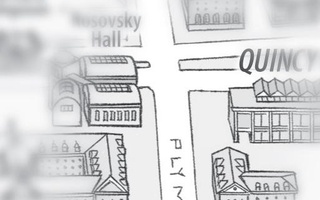‘Classical music’ conjures images of grand orchestras and animated conductors paying heed to the western canon. While all of these were present in “Chinese Symphonic Masterpiece II: A Journey to the West,” music director and conductor Hanjay Wang ’11 made a complete departure from a typical classical music concert by juxtaposing a popular Western piece with lesser-known Eastern-inspired works. By providing a fresh interpretation of an age-old tradition, Wang inspired a dialogue to address the plethora of approaches to music.
“A Journey to the West” took place April 15 in Paine Hall as a sequel performance to “Chinese Symphonic Masterpieces.” The concert began with Taiwanese folk-inspired “Plum Blossom Country” by Masaaki Hayakawa and ended with “Allegro from Piano Concerto No. 5 in E-flat major, Op. 73 ‘Emperor’” by German composer Ludwig van Beethoven. In this movement from east to west, the newly composed piece “Journey to the West” served as both a transition and the focal point.
Award-winning American composer and Program Assistant at the Harvard School of Engineering and Applied Science Oliver L Caplan composed the concert’s namesake. Inspired by renowned novel “Journey to the West” by Wu Cheng’en, the composition was a musical representation of the protagonist’s pilgrimage to India as atonement for past sins. The protagonist, monkey Sun Wu Kong, is a bold and mischievous king with extraordinary magical talent. The composition follows his journey of personal growth from a playful, puckish monkey to reflective, mature hero over the course of four movements.
Caplan took ample time to conceptualize the intellectual framework for the piece before he made any of the movements. Latching onto the theme of personal growth in the novel, Caplan sought to take one melody and represent it in four contrasting ways in the four movements. Soloists Kevin Leu ’11 on the flute and Charles Vanijcharoenkarn ’11 on the erhu were cast as the yin and yang of the monkey’s character, Caplan said. Leu embodied the yang as the fiery and mischievous side in the first movement, “Monkey’s Mischief,” while Vanijcharoenkarn represented the more soulful and softer part of the monkey’s personality in the second movement, “Mountain of the Five Elements.” The third movement showcased the orchestra as a whole as the monkey makes his journey to India to retrieve Buddhist scriptures and bring them to China. In the final movement, “Illumination,” the flute and erhu soloists played in duet to symbolize that the yin and yang of the monkey’s character were finally achieving balance.
After meeting Caplan through a professor in the OEB department, Wang enthusiastically asked him to compose a piece based on “Journey to the West.” Both found the experience extremely meaningful. “Working with Oliver is something really special because we are getting the chance to work with an up and coming composer. He brings a lot of excitement to the event,” Wang said.
Other highlights of the evening’s performance included piano soloist and associate of the Music Department at Harvard University Seda Röder, as well as live electronics by Edgar Barroso, a PhD candidate in Music Composition at Harvard. Both were featured in the culminating piano concerto. Several alumni and staff members were also highlighted as guest musicians in the orchestra. “We really get a sense of the holistic community at Harvard with this performance. The student and staff collaboration is very close in this production,” Caplan said.
Encouraged by positive feedback from audience members and featured orchestra musicians after last year’s “Chinese Symphonic Masterpieces,” Wang decided to do a second concert this year. He said that the process of following such a successful concert was very challenging. After playing two of the most famous works of Chinese symphonic music last year, Wang came up with the concept of having an eastern and western fusion concert for this year’s performance.
Days before the event, Caplan described how anxiously he waited to hear the whole program contiguously. Planning the concert as a journey from east to west was a novel concept. “Hanjay is an extremely gifted conductor. I’ve been very impressed seeing him work in rehearsal,” Caplan said. “He has a very natural musicality, and his student peers respond very well to him. He has such a natural sense of the score.”
Chinese Symphonic Masterpieces I and II have ignited excitement amongst both students and faculty members at Harvard. Wang’s cross-cultural innovation represents a greater movement towards cohesion across cultural divides.
Read more in Arts
TUnE-yArDs Conjure Subtly Dark PopRecommended Articles
-
Hopped Off a Plane at LAX...You may have heard of Mike A. Einziger; he’s best known as the guitarist of the band Incubus, but he’s ...
-
 Theater Previews
Theater Previews -
O’Brien’s ‘Mrs. Adams’ Envisions A Nuanced PastIn “Mrs. Adams in Winter: a Journey in the Last Days of Napoleon,” against the background of Adams’ troubled marriage and peripatetic life as a diplomatic wife, British historian Michael O’Brien marshals an impressive array of sources in order to recreate Mrs. Adams’ journey across Europe.
-
 Journey 2 the Hackneyed Nightmare
Journey 2 the Hackneyed Nightmare -
 An Empty, Canted Street
An Empty, Canted Street -
An Artist’s Journey From “LOST CHILD!” to FilmmakerIt is not every day that one gets the chance to walk through the life of a filmmaker, writer, and actress all in the span of two hours. “LOST CHILD!”—a one-woman one-act staged by the Institute of Contemporary Arts on Sunday—was written and performed by Miranda July, the versatile artist whose fiction has been published in “The New Yorker” and “The Paris Review” and whose films have appeared in the Sundance Film Festival.













